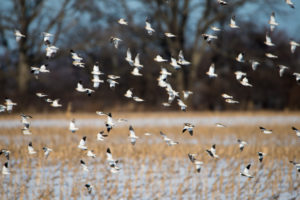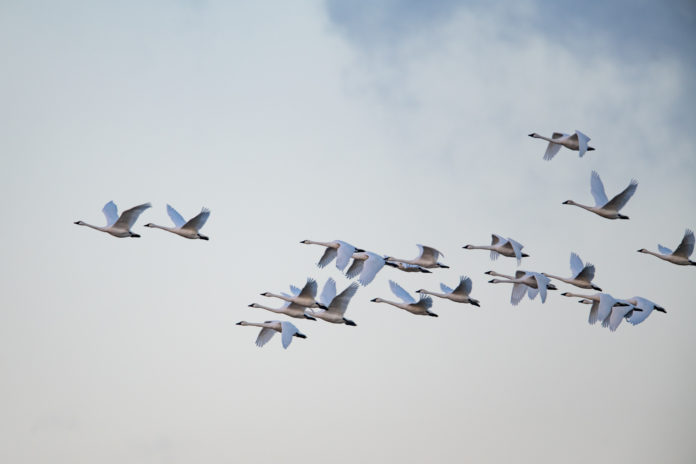By Larry Cornelis – President, Sydenham Field Naturalists
Bird migration is one of nature’s most awe-inspiring natural phenomenon.
Consider the dangers and challenges birds face during migration.
Severe weather, predation, habitat loss, people with guns, great distances and huge bodies of water to cross.
Some migrating birds are very small, weighing less than 10 grams (warblers, kinglets) but some are much larger (raptors, waterfowl), both with their own physical challenges.
How do they travel tremendous distances without becoming lost or fatigued beyond recovery?
Definitely super-being qualities.
Migration patterns very greatly from long distance journeys to distances of a few hundred miles
or less.
Locally, we are seeing a north/south pattern but there are birds and places where it varies such
as toward coastal areas and from higher to lower elevations and back.
Some birds fly non-stop for days and others stop every day to refuel.
They must prepare for such strenuous activities by building fat reserves, changing feathers and building muscles.
They can add as much as 25% to their normal weight by putting on the fat so they have the energy for the task.
Basically, it’s about food availability.
Especially for insectivores like Swallows and Flycatchers.
Birds fly north from their wintering grounds to our rich insect emerging landscapes.
They especially need insects to raise their young.
Of course, the really long-distance migraters are the most fascinating to consider.

Bobolinks make one of the longest distance migrations flying from Canada to the grasslands of Argentina.
It’s hard to imagine that as I write this, the bobolinks are eating caterpillars in Argentina.
There are ducks and raptors that fly to Argentina too.
Some of our Turkey Vultures migrate as far as the Amazon basin.
Artic Terns are famous for their round-trip migration of 18,000 kilometers (9,000 each way) from the Artic circle to the Antarctic circle and back.
I recently learned from a ‘Birds Canada’ report that the longest and most impressive migrating bird is the Bar-tailed Godwit.
These birds breed in Alaska and migrate non-stop across the Pacific Ocean to New Zealand.
That’s over 11,000 kms one way.
The longest distance was recorded by a male and he flew 12,200 kms over 11 days without stopping (he was satellite
tracked).
When they return, they take a different route back from New Zealand to China and the Korean Peninsula and then back to Alaska, some 15,000 kms long.
So that equals a round trip of over 25,000 kms annually.
Incredible!
Migrating patterns are important to birders.
I always say that if I could only bird watch for a few days a year, that time better be in early May to get the most species.
Birding competitions in Southwestern Ontario can tally as much as 150 species in 24 hours during May because of all the birds migrating through.
The return of Warbler species is especially anticipated with excitement.
These little feathered jewels are very colourful and migrate in mixed flocks of different species.
I’ve seen over 10 species in one tree – wow!

The Lake Erie shoreline has excellent birding but there is also the Huron Shore Flyway, where birds follow the Lake Huron Coast from east of Sarnia to Tobermory.
Some of our warblers make great journeys too.
The little Blackpoll Warbler flies from Nova Scotia or Maine south, across the Atlantic Ocean to Brazil (Amazon basin) non-stop.
Very impressive.
The Purple Martins that nest in the T-14 bird house that the Sydenham Field Naturalists erected in Crothers Park in Wallaceburg are also currently in the Amazon Basin.
If you are interested in bird watching, any day is a good day but during migration is the best.
These migrations are a great wonder.
For more details, visit: http://www.sydenhamfieldnaturalists.ca/
















